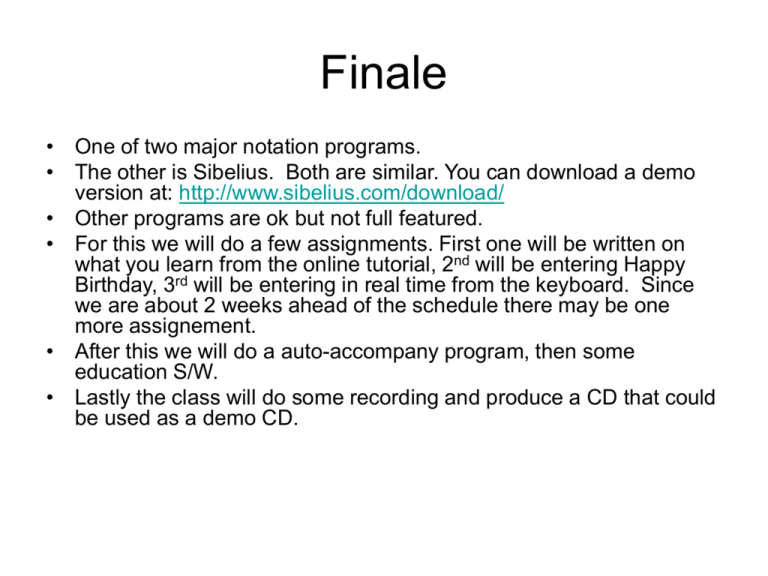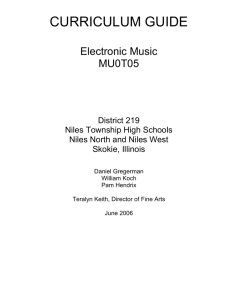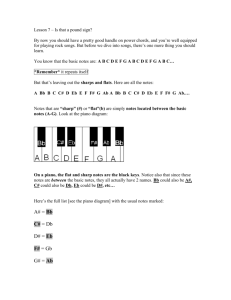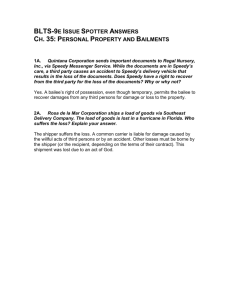Computer Applications In Music
advertisement

Finale • One of two major notation programs. • The other is Sibelius. Both are similar. You can download a demo version at: http://www.sibelius.com/download/ • Other programs are ok but not full featured. • For this we will do a few assignments. First one will be written on what you learn from the online tutorial, 2nd will be entering Happy Birthday, 3rd will be entering in real time from the keyboard. Since we are about 2 weeks ahead of the schedule there may be one more assignement. • After this we will do a auto-accompany program, then some education S/W. • Lastly the class will do some recording and produce a CD that could be used as a demo CD. After reading how to use the manual go to help and read Chapters 1-3 in the manual. Do a paper for assignment 6 on how you will use Finale or a notation program in your music development. Answer the following questions: 1. 2. 3. 4. 5. Why use the computer to notate? What advantages does the computer have in doing notation? What could be future uses for the computer in notation? How will you use the computer and notation? What roadblocks do you see to learning how to notate on the computer? 2) Which website that have lots of MIDI files to download? How to put a MIDI on my web page? What is the difference between MIDI and MP3? Let’s start by answering these questions: MP3 files are audio files that have been compressed. The compression takes the audio files and makes them smaller with some minor loss of information. Digital data (16 bits) is in the original Wave file. This is at 44KHz with 16 bits. That data would normally be run through a DAC (Digital to Analog Converter) and converted into an analog signal to drive the speakers. With MP3 the data is compressed and on playback it uncompressed but is still handled in a similar matter. A 3 minute MP3 would have about 4Meg of information. MIDI files are computer files that are MIDI data. No music until it goes through a MIDI instrument and the digital data is then read to control the instrument and make the music. A 3 minute MIDI file would have about 1K of data. Much smaller and easier to handle. First Finale Assignment • Watch the Finale Tutorial. • Take notes each section. For this first assignment we will only do up to Hyperscribe for entry. But type up your notes and turn them in on the whole 20 chapters. • Make sure that you ask instructor questions about areas that you don’t understand. • Enter Happy Birthday as on the next page. Use simple entry for this. I expect the final outcome to look exactly like the following page. • You will have all day today and Thursday to work on these two assignments. The write-up is due next Monday, Oct 4th. • Send me the file of Happy Birthday by Oct 11, 2004. At this point class will watch part of the tutorial. • You can do this with Finale or with Notepad. • You have one week and 3 days to complete this assignment. Let’s discuss this. Finale Tutorial • • For this assignment you must finish watching the entire video tutorial on Finale. Answer the following questions: – Explain the steps setting up your score. – How do you create pickup measures? – How many tools in the main tool palette? – How do you add new staves? – What is the difference between page view and scroll view? Why would you choose one over the other (give examples). – Explain how to change the key, time or clef. Give at least 2 examples of the clef. – Explain in simple entry tool how to enter notes using the number keys. – Explain exactly how to use your computer keyboard and speedy entry to inter notes. – Explain in Speedy Entry how to enter notes. For an example use a C major scale and then the C major chord all quarter notes. – Explain steps to entering music using Hyperscribe and a MIDI keyboard. – Why is setting up the Hyperscribe correctly key to a correct entry of your piece? – Explain Quantization. – Can you enter music with a non MIDI instrument? Explain how if you can do that. – Explain the steps in copying a section of music and pasting it somewhere else in the score. – Explain at least 5 things that the mass edit tool can do, how to do them and why it is important. Cont. • • • • • • • • • • • • • • • • • Explain 2 different ways to add lyrics to your score. How do you add chord symbols? How do you show fretboard diagrams? How do you add staccato to a note? To a group of notes? Explain 3 different shortcut keys for adding articulation. How do you pick a note duration range to apply articulation (like 1/8th to ¼ notes) How do you apply performance markings to a rhythmic section. (explained in articulation video). Explain use of resize tool. How do you you change the size of just 1 staff? How do you join measures from one line to the next? Very important for some of the pieces you already did. How do you freeze the number of measures per line in your piece? How do you just listen to one note or chord in the playback menu? Explain how to use smart playback. How do you print individual parts of a score? Explain how to create a worksheet for a class in finale. Explain the steps to scanning a piece of printed music. Explain how to use at least 3 plug ins and why you would use them in your music. How do you create slashed symbols for rhythmic notation? Intermediate Exercises • The following will prepare you for learning the various tools. • Before even doing piano keyboard entry we will work on speedy entry. It is almost as easy as entering with a keyboard with the advantage of more control – less mistakes even for pianists. Speedy Entry • This next assignment is to use speedy entry to enter Aura Lee • Choose Speedy Entry – note looks like Italic. • Under Speedy Entry heading turn off use MIDI Keyboard. For this assignment you will use your computer keyboard. • The following page is what your output should look like. • Start by setting up the score. Remember that it is in the key of D and it is in Common time. • Choose Speedy Entry and using the number keys you can enter the notes by placing the cursor over the note you want and then pressing a number. For example for a quarter note you will press a 5. The first note is an A on the staff. Start by clicking the first measure, you will see a bar with what looks like a whole rest. Hold your mouse over the note (in this case an ‘A’) then press the 5. You will see an A note. • To enter a rest enter the timing of the note (1/4 note as an example) then hit backspace and a ¼ note rest will appear it the note’s place. • One other thing to do is use redraw screen under the view menu every so often. It cleans things up. Be sure to put your name on it • Set it up exactly as the paper from the slide before but use portrait and not landscape. Now America • Again speedy entry but now instead of the mouse use the up down arrows. • Set the score up. Be sure that you use ¾ time. Set this up for vocal with a soprano. • Enter the name of the piece, your name, etc. • Enter the notes before entering the chords. • If you make a mistake on entering the notes click on the measure then the note and change it using the up/down arrows. Once the notes are entered • Enter the chords it is the tool that is CM7. • When you do this look at the chord menu make sure that type into score is selected. • Click on the first note and enter the chord. • You can then enter the 2nd chord by clicking on the note that is under where you want the chord to appear. Or you can space over to that note using the space bar (in newer versions, such as the one you are using, you can also use the tab key). • Then the fermata. Checking your work • Once you have entered the notes and chords you want to hear what you did and was it correct. • Use the play controls for this. You should hear the melody and the chords. Listen closely to hear if there are any mistakes etc. • It is vital that you check what you have entered with the final output. I find that I will have the most obvious mistakes if I skip this – it can be downright embarrassing. Remove Staff Name • Next remove the staff name. • Select the staff tool. • Select edit staff attributes from the staff menu. • Under Items to display, uncheck staff names. This doesn’t erase the name it just won’t print it. You can always put it back in later by reversing the process. Page Layout Tool • Page layout tool is the last one on the top line and it looks like a page. • Select it. • If you can’t see the entire piece on the screen, use the Hand Grabber Tool (looks like a hand) to center it with the mouse. • If you still can’t see the entire page then choose view menu and go to 75% or even 50%. • Now go to page layout menu, select Fit Music and type in 4 for 4 measures per line. Amazing Grace • Pickup notes, parts on one score, guitar fret-boards, dynamics. • Look at the next page. For the pickup measure that is handled when you set up the piece. • You can use either speedy entry method for this. • Set the pickup to 1 ¼ note. Enter the notes • Enter the top line first using speedy entry. • Then using the simple entry tool enter the harmony. • Enter the chords as in the previous piece. • Under chords check show guitar fretboards. • You may have to use the page layout to add space above the staff for the chord names and diagrams. Choose page layout and then use the handles on the staffs to make room. When you have finished this use the edit menu update layout option. Add Dynamic Markings • Use the expression tool (mf). • Double-click just below measure 1 to enter the piano making. Expressions are attached to the measure or to specific notes. • Select the dynamic marking from the dialog box. In this case the p (piano or soft) marking. • Click on the handle and drag it slightly to the left of the first note. • Repeat this process for all of the dynamic markings. • Remember to save often. Again I use revision names. Amazing Grace Rev A, … Rev B, … etc. Change keys • When you have finished in this key transpose to a number of other keys (you choose at least 4). Keep the melody towards the center of the staff as much as possible. • Use the key signature tool first. Choose it (3rd tool from the left). Double click on the staff and then change the key. You will learn later that there is another easy way to transpose a piece. • Turn in all of these by email to fmarkovich@paramit.com. Single Staff with Lyrics • Will use Three Blind Mice. • You can enter the notes any method you want. • Chords must be entered by typing into score. • Set this up – note key of D (2 sharps), 6/8 time, no pickups. Look ways to save time • • • • Use copy and paste to speed this up. Enter measures 1 and 2. Using the Mass Mover Tool. Select the first 2 measures by holding down the shift key and then clicking on measure 1 then measure 2 – you could also click around the 2 measures. • Use ctrl C to copy. Then highlight measures 3 and 4 and use ctrl V to paste. • Look for other places to do this also. Playback to hear • Listen to see if there are any mistakes. • Correct them. • Remove unused measure at the end with the mass mover tool. • Using the bar line tool add a double bar at the end of the piece (you should already know how to do this). • Then type the chords into the score. • You can position the chords by dragging the arrows to the left up or down when entering the chords. Add Lyrics • • • • Use the lyric tool. Choose Type into score. Click on the first note. Again use the tab or space bar to move to the next note. • Entering a syllable break. To split words type in the first part and then hit a hyphen and type the 2nd part of the word. • You can change the location of the lyrics much like the chords. • You can also the font etc. Experiment with that. Entering Text • Start by doing the Title. Make the font large enough to stand out (I like 24 font myself). • Double click to enter other text. Realize that text is not tied to the music. In other words it will stay just where you put it.. • Fit music to 4 measure per line as before. • Then group measure 9-14 to 3 measures per line. Use the mass mover tool and drag a box around measure 9-14. Those measures should be highlighted. From the Mass edit menu choose “fit music” and then choose 3 measures. Articulation • Bring a disk to the professor. He will put a file for you to use. It will have all of the notes entered and you will then enter the articulations. • The following page has what the piece will look like when you have completed it. • No articulation is on the file, no dynamics, rehearsal number, repeats, grace notes, etc. You are to figure out how to put all of those into the score. This part of the assignment will not be spoon fed to you!!! Here is what the final work should look like This is what you start with. Don’t worry some hints. • Use simple entry for the grace notes. • Use Articulation tool for articulation. • Use repeat tool for repeat markings. Large coda at the end could be a text entry. • Use text for notes. • Dynamic tools for dynamics. You get the idea. • Rehearsal letters are in the measure tool, you click the measure then double click the box. Adjust the box on the left to make it large enough but not too large. You must experiment with this! • The hard part is getting everything!!! Moses adding slurs etc. • Again I will give you the entry and you must add in the slurs etc. • This one will work on modulation, Slurs, phrase markings, crescendos etc. • One last assignment before Hyperscribe. • I want you to work at least some time in the lab today. I was here a bit late on Tuesday and we found that the sound cards have an issue. I will be working with IT to finally resolve it. May mean different sound cards. • For recording we need to agree on a time and day. It will be at least 6 hours total – but you don’t all need to be here the whole time. It will take the place of 2 weeks of class time. After we record, the class will mix it down and you will each product a CD of what you recorded. • You can bring in others (to a point) to play parts for you. An example is a pianist to accompany a vocal part you lay down. • Or you could sequence a backgound or even use Band In A Box (we will be covering that later) Final output should look like this. This is what you will start with. Take your time on this. Step one is to do the modulation. Use the key signature tool for this. Click on measure 18 and select measure 18 through the end of the piece, the n change the key to G Major and transpose notes up. Then enter the slurs using the Smart shape. Click on the starting note and move the cursor to the ending note and click on it to attach it. Next do the Crescendo marking. Again use the smart shape. You double click where you want it and drag and release where it ends up. If you don’t do it long enough or if you do it too long you can click on the handle and change it in the same manner! To enter the ritard use the expression box then use smart shapes dashed bracket tool. Hyperscribe and Speedy Entry Using Piano Keyboard • This will be used for your original piece. We will cover this in about 2 weeks. • Midi entry can be fast but it is also difficult to play exactly and will require knowledge of such issues as quantization setting. • Lecture to follow on that topic. • We may also break from notation for a short while to look at other applications – a break may be needed. Hyperscribe • First need to cover some basics. • Quantization is one of the keys. (explain) • Settings – beat source etc. View the video in class. • May want to practice it a bit before trying to record it. Can enter with piano or also with any MIDI instrument. • I will bring in a MIDI guitar one day to demonstrate. Composition Notation Assignment • • • This assignment will be using Hyperscribe. Pick a piece that you have music for or better yet compose your own piece. If you compose your own piece you can earn an A+ on this assignment. If you pick a piece then your top grade you can earn is B. I really want you to write a piece. If you are not a music major there is only a bonus for doing your own piece. If you compose your own piece you will not be required to have lyrics, otherwise you will need to put lyrics in the piece or have an piece with at least 4 instruments. Enter the following: – – – – – – – – – • • Notes Title Composer Lyrics Chords (in symbol form) Articulation. Time and key signatures Correct clef’s Space music so no more than 4 measures per line Must be at least 24 measures long. You may have to start it in Notepad and then move it to Finale in order to complete it and have it look close to the original! Due Dates • Since I have added in a bit more the due dates are changing. • For Happy Birthday and the Finale questions paper they are Oct 4. • For the other assignments up to but not including the Articulation the due date is Oct 18. For the articulation it is Oct 25. • I want you to start thinking about your composition, I will give you more time on that (2 weeks) after the last assignment but you need to start working on it now! • We will talk a bit about what I am looking for and how to go about writing a piece.




